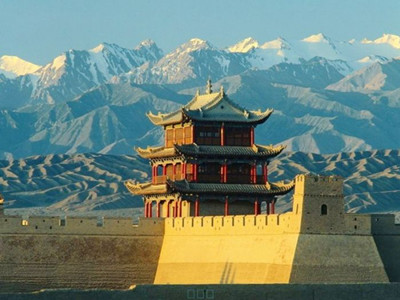Yumenguan Pass [ Related Itinerary ]
 Located 90 kilometers northeast of Dunhuang City, Yumenguan Pass was a strategic pass along the ancient Silk Road and was one of the two important passes on the western frontier of the Han Dynasty (206 BC - 220). With the history of more than 200 years, witnessed the history and the development of ancient China, on June 22, 2014, it was successfully listed as a World Heritage Site by the UNESCO.
Located 90 kilometers northeast of Dunhuang City, Yumenguan Pass was a strategic pass along the ancient Silk Road and was one of the two important passes on the western frontier of the Han Dynasty (206 BC - 220). With the history of more than 200 years, witnessed the history and the development of ancient China, on June 22, 2014, it was successfully listed as a World Heritage Site by the UNESCO.According to the historical records, the Yumenguan Pass was originally built during the reign of the Emperor Wu of the Han Dynasty. Since the Qin and Han dynasties, the warlike Huns usually threatened the weak Han rulers to allow the daughters of the imperial families marry the Huns' leaders. If not, the Huns would incite the war. And because of the weak power, the rulers of Han had to agreed. When the Emperor Wu rose to power, he appointed the general Huoqubing lead soldiers fight against Huns. Finally, the Hun's troops were driven back. In order to strengthen the stability of the western frontier, Yumenguan and Yangguan Passes were built.
In ancient time, Yumenguan Pass was served as a post station for businessmen, military generals and ambassadors. Why called Yumenguan (Jade Gate Pass)? In ancient, this pass was the the only way to transport the beautiful jade to the inner China via the Silk Road, so got the name. Yumenguan Pass has witnessed the prosperity of the business along the Silk Road - silk from China was transported to the western region and meanwhile the western music and religion were introduced to central China. It is said that the grapes, pomegranates and walnuts now growing in central China were also from the western area through the pass.
With the decline of the Silk Road, Yumenguan Pass has lost its historic function and was forgotten by people. Year after year eroded by the flowing dunes, the walls were disappeared and for a distant view, it is just a rectangular castle standing in the Gobi desert lonely. Climbing to the top of the pass, visitors can see the relics of the Great Wall and beacon towers scattered sparsely in the desert. The remaining relics here present the evidence of civilization and create an atmosphere of recalling the flourishing past.
Related Itinerary